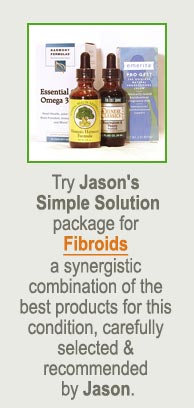PAGE NAVIGATION
WESTERN INTERPRETATION AND TREATMENTS
FIVE ELEMENT HEALING INTERPRETATION
COMPLEMENTARY TREATMENTS
WESTERN INTERPRETATION AND TREATMENT
Fibroids are benign tumors made of fibrous tissue growing in or on the uterus; there is no known cause for these growths. Although the tumor itself is not considered dangerous, fibroids can cause problems such as profuse bleeding or, by pressing against other organs, urinary urgency, incontinence, and pain due ro nerve pressure. Over 50 percent of women over the age of forty have fibroids, which are responsible for one-third of all gynecological hospital admissions.
If the fibroid is not causing symptoms, most doctors take a “wait and see” attitude, since the tumors often disappear during menopause. Drugs to induce premature menopause (Lupron or Synarol) are sometimes prescribed for short time spans, usually to shrink fibroids in preparation for surgery. Progesterone therapy is prescribed if bleeding is a problem. Myomectomy (surgical excision of the fibroid tumor) is sometimes recommended, and hysterectomy is frequently advised (30 percent of all hysterectomies are performed for fibroids).
FIVE ELEMENT HEALING INTERPRETATION
The Chinese offer two interpretations for fibroids:
- Liver chi builds up and stagnates in the Lower Heater (pelvic region) leading to congealed blood; if not corrected, the congealed blood is transformed into a mass (fibroid).
- A deficiency of Liver or Spleen chi can also lead to a condition of congealed blood in the Lower Heater, for the deficient chi is unable to keep the blood moving, which leads to stagnation.
COMPLEMENTARY TREATMENTS
SUPPLEMENTS
B-complex vitamin (use the high-potency B-100 formula*)
- Vitamin E (alpha tocopherol, 400-800 mg/day)
- Magnesium (1,000-1,500 mg/day)
- Proteolytic and pancreatic enzymes (take in between meals)
- Natural progesterone cream. Progesterone is a hormone made by your body that plays an important role in balancing out the effects of estrogen and other hormones. If you have too much estrogen and not enough progesterone, your body may be thrown out of balance. As fibroid are known to be estrogen fed, natural progesterone supplementation keeps the estrogen in check, thereby not feeding the fibroid. It is common for women who are approaching perimenopause, and even through menopause, to produce smaller amounts of progesterone. Progesterone cream can supplement your body’s own levels and lead you back to a state of natural balance.
- Omega-3 fatty acids (eicosapentaenoic acid or EPA): These anti-inflammatory agents have general supportive effects on the circulatory system and a specific ability to reduce blood cholesterol levels. Omega-3′s reduce the joint stiffness and soreness caused by rheumatoid arthritis and improve flexibility. They are found in cold-water fish such as salmon, mackerel, herring, anchovies, sardines, and tuna. Eat two or three servings offish weekly, or take a 1,500-mg. supplement daily.
- Gamma linoleic acid: GLA has well-documented anti-inflammatory actions and a balancing effect on the immune system. As many researchers and clinicians theorize, arthritis and other autoimmune diseases are caused in part by the body’s inability to manufacture GLA and other essential fatty acids. So this is a particularly important supplement for arthritis patients. GLA is available in oil of evening primrose, borage seed oil, and black currant seed oil. Take 1,500 mg. daily. GLA and omega-3′s work well together and are often found in combined formulas. Whether you take them separately or in one formula, make sure you get 1,500 mg. of each daily.
*The B-1 00 designation indicates that the product contains 100 mg each of the B vitamins. Recommended dosage is one tablet per day. or as directed.
TOPICAL TREATMENT
Castor oil packs, applied over the lower belly, stimulate circulation to the uterus and may help to reduce fibroid size. Kits can be ordered from the Woman to Woman Center, One Pleasant Street, Yarmouth, Maine 04096; (207) 846-6163.
EXERCISE
Because stagnation is involved, daily exercise is considered vitally important; acupuncture, chiropractic, or body work may help to free the energy in the pelvic area.
DIET
Increase natural phyto (plant) estrogens (found in soya produces, brown rice, yams). Avoid synthetic estrogenic foods (meats, poultry, dairy products, eggs), refined carbohydrate products (sugars, white flour products), alcohol, caffeine, nicotine, and oral contraceptives.
HERBAL ALLIES

Common Uses
- Relieves symptoms of PMS, including irritability, depression, headaches, bloating. and cramping
- Relieves menopausal symptoms such as hot flashes, night Sweats, depression, anxiety attacks, and flooding, or heavy periods
- Balances and regulates the menstrual flow
- Reduces uterine fibroids
- Helps resolve endometriosis
- Clears up hormonally related acne and other skin problems
- Protects against osteoporosis and reproductive cancers (especially breast and endometrial cancers)
- Induces emotional calm
Common Uses
- Reduces or eliminates hot flashes, night Sweats, and cold Sweats associated with menopause
- Balances the female reproductive cycle
- Reduces or eliminates headaches, especially those associated with
menopausal changes - Resolves psychological feelings of being blocked or stuck
- Eases irritation, lifts depression, evens out mood Swings
- Relieves menstrual cramps
- Helps nursing mothers dry up their breast milk
- Acts as an effective mouthwash for cold sores and mouth ulcers and as a gargle for sore throats and laryngitis
* Caution: Discontinue use if the mouth or vagina is excessively dry. Avoid using large amounts of this herb over long periods of time.
• Dandelion root, (Taraxacum officinalis) A story is told about a man who tried everything within his power to rid his garden of dandelions. Having exhausted all known possibilities, he appealed to an expert gardener, who gave him this advice: “I suggest you learn to love them.”‘ Once you learn about the astonishing healing powers of this simple weed, you will find it easier to cherish its ubiquitous presence.
One of the richest of all plants in nutritive value and a cornerstone of traditional herbal treatments, dandelion is the archetypical Liver tonic, helping this vital organ system detoxify and cleanse the blood. Dandelion is also highly valued as a nourishing kidney tonic; the French word for dandelion, pissenlit, literally means ‘piss in bed’ a literary testament to dandelion’s dramatic diuretic effects. Dandelion also has numerous gynecological benefits and is particularly helpful for relieving bloating and digestive disturbances associated with PMS or menopause, with the beneficial side effects of increasing energy, supporting digestion, and improving metabolism.
Common Uses
- Traditionally used for any condition involving the liver and gallbladder, including food sensitivities, hepatitis, and cirrhosis of the liver; also used to prevent gallstones and infections of the gallbladder
- Supports digestion and improves metabolism, allowing proper assimilation of food and drink
- Reduces bloating and/or water retention (extremely effective for premenstrual water retention)
- Gently cleanses the blood to help resolve acne, itchy or sensitive skin, and other skin conditions
- Regulates blood-sugar levels and resolves hormonally induced blood-sugar fluctuations
- Provides a rich source of usable iron, making it an invaluable ally for women who bleed heavily
COMPLEMENTARY HERBAL FORMULATIONS
(Traditionally, in both Western and Chinese cultures, the combining of herbs is of superior value than the individual parts. After over thirty years as an herbalist, the synergy of certain herbs became apparent and this understanding has been used to create our own Integral Health Apothecary formulas. We are also listing tradition Chinese herbal tonics which exemplify this synergy.)
- Jason originally created Integral Health Apothecary’s Women’s Harmony Formula for supporting women dealing with PMS, as the harmonious blend of Eastern and Western herbs help to promote harmony in their hormonal cycles. Over the years it has proved effective in dealing with fibroids as well. It’s gentle nature helps to promote gynecological health. Herbs are not hormonal in and of themselves but support the body to balance it’s own hormonal machinery, therefore it is important realize that this does not have an immediate effect, and takes up to three months to reach it’s potency. Ingredients: Vitex agnus castus (Chaste tree fruit), Cimicifuga racemosa (Black cohosh), Bupleurum falcatum (Bupleurum root), Peonia latiflora (White peony root), Salvis officials (Sage), Dioscorea villas (Wild yam), Viburnum prunifolium (Black haw), Rubus idaeus (Red raspberry leaf), Glycyrrhiaza glabra (Licorice root), Lavandula officinalis (Lavener)
- Bupleurum and Peony is the most used herbal tonic in Japan, as this resolves what is called ‘stagnant Liver Chi’. In classical Chinese medicine this type of formula was seen as balancing the flow of Qi in cases of stagnation. The practical applications are that it will help restore harmony and balance to the female hormonal systems for woman who experience PMS symptoms, fibroid tumors, irregular cycles, menopausal imbalances, and mood swings. It is also effective for both genders in resolving digestive issues and the swelling and bloating associated and GERD. Ingredients: Bupleurum root, White Peony root, Dong Quai root, Poria sclerotium fungus, White Atractylodes rhizome, Fresh Ginger rhizome, Moutan root bark, Gardenia fruit, Chinese Licorice root and Mentha (bo he) herb. Herbs processed using grain alcohol, vegetable glycerine and water.
 ACUPOINTS
ACUPOINTS
- Liver 3,
- Spleen 6,
- Spleen 10,
- Liver 14
MIND/BODY/SPIRIT CONNECTION
The symptoms might be expressing these questions:
- “What is the purpose of the fibroid-what is it telling me about how I mIght have blocked my energy or creativity?”
- “Where do I feel stuck in my life?”
- “How can I free up my energy and live life more fully?”


